Barcombe Hill
'Alone' is set in the English village of Barcombe Hill. No village of this name exists.
One non-settlement site bearing the name 'Barcombe Hill' in England is an Iron Age hillfort and Roman signal tower on Hadrian's wall - not far from the better known Roman fort of Vindolanda. This Barcombe Hill also has the distinction of being an Ordinance Survey trigonometric point. There are also towns named Barcombe in Somerset and East Sussex, and a Batcombe Hill in Dorset.
Also mentioned in 'Alone' is a stone circle known as The Devil's Hoof. Although the Devil's hoofmarks are a common symbol in English folklore, there does not seem to be a well known stone circle bearing this name anywhere in the country.
Brighton
The city of Brighton, and the Royal Pavilion, feature in the CD adventure 'Aftermath' where it appears as the location of John's family home. Some scenes were also set in the Brighton Pavilion at night.
| The Royal Pavilion, Brighton, is a oriental palace, transformed from its original state as a country farmhouse on the order of George, Prince of Wales. The prince rented `Brighton House' in 1786, having it enlarged and adapted over the following fifteen years. In 1803 an Indian theme was selected and by 1823 the palace was complete in its current form bringing the Prince Regent, and later King, tears of joy. The majority of the transformation was accomplished by architect John Nash. Nash had already worked for the King on the construction of Royal Lodge and other projects, but Brighton Pavilion was his grandest work. | 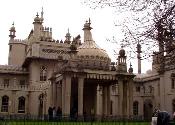 |
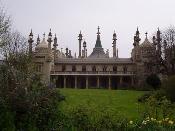 |
(Left and Above) The Brighton Pavilion, seen in April 2007 (photo: Jackie Clark)
The Pavilion was well liked by King George's daughter Princess Charlotte, and also by the young Queen Victoria. However, the growth of crowds in Brighton due to the advent of the railway made royal visits wearisome. In 1845, Queen Victoria replaced the Pavilion with Osborne House on the Isle of Wight as the royal holiday residence and in 1851, the palace was sold to the City of Brighton (after protracted legal wrangling). After suffering depredations due to war-time use in 1939-1945, a programme of restoration was launched in the 1950s and the Pavillion is now a major tourist attraction. |
Bristol
Bristol features in the double CD story `Rachel'. St Martin's monastery in Abbots Leigh (first seen in `End of Silence' but not named until `Rachel') is located just outside the city, while Father Daniel's house and the `Mud Dock' cafe both lie in Bristol proper.
The city and county of Bristol is some hundred miles from London in the south-west of England. Although the river valley has been settled for millenia, the influencial city in the area during Roman times was nearby Bath. Bristol acquired a Norman fort in the 11th century, and developed into a major harbour town in the 12th century.
The port city lies on the River Avon, not far from the Severn Estuary and has been associated both with early exploratory voyages (being the home of the 15th century explorer John Cabot) and with the later transatlantic tobacco and slave trades in the 17th and 18th centuries. In the nineteenth century, the city became closely associated with engineer Isambard Kingdom Brunel, being the terminus of his Great Western Railway, site of his Clifton Suspension Bridge and the home of his innovative shipyards. Bristol is now once again home to Brunel's SS Great Britain.
|
In more recent years, the aerospace industry has been an important
element of Bristol's ongoing prosperity, with several companies
including BAE
Systems and Airbus based
in the village of Filton just outside the city. Both Abbots Leigh and
the Mud Dock cafe are real Bristol locations. Mud Dock is a combined
bicycle shop, bar and restaurant situated in a converted warehouse on
Bristol's Floating Harbour.
The floating harbour is a series of docks and wharfs with a water level maintained by massive lock gates against the very large tidal range of the river Avon. The docks were a heavily industialised area through the 19th and 20th centuries, but have since been regenerated into largely commercial, entertainment and residential usage. The Mud Dock cafe was opened in June 1994 and has been thriving ever since. Since 2002 it has expanded to include the Bike Shed - a parking, locker and shower facility for cyclists. |
 (Above) Mud Dock Cafe, Bristol in June 2007 |
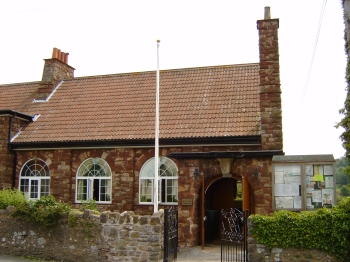 (Above) Abbots Leigh Village Hall, Bristol in June 2007 |
The ancient manor house of the village of Lega was granted to the Bishop of Coutances by William the Conqueror, and became the rest house of Bristol's Augustine monastery. Many of the village's distinctive buildings had an ecclesiastical origin and the settlement became known as Abbot's Leigh as the language evolved. The village - now technically lying in North Somerset and just a few miles from Bristol - no longer has an active monastery. Abbots Leigh is notable as the location of Leigh Court, the local manor on the south bank of the Avon Gorge, and since it sits on a strontium deposit that was mined in the early twentieth century. Ore was carried by horse-drawn tram down the gorge to the river Avon for shipping. |
The Traditional British Seaside Resort
|
Mayview-on-Sea appears in 'The Power of Fear'. While Mayview itself may be an invention of Big Finish, the English seaside resort is a traditional feature of the British summer. While the waters of the Irish Sea, English Channel and North Sea can be cold, during the summer months it is quite possible to paddle or bathe on the beaches of the English coast.
A typical resort - in this case, Southend-on-Sea - seen at Easter 2007. The pier-head fun-fair (right) and concession stands selling bucket-and-spade (below) are both traditional seaside features. |
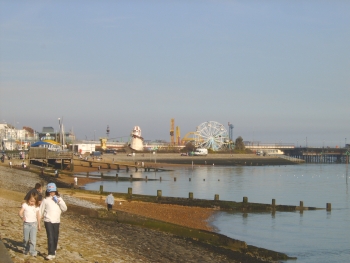 |
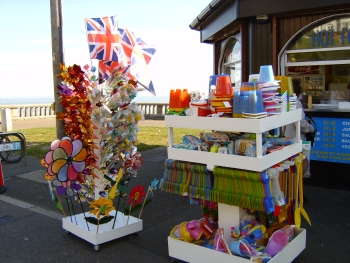 |
An entire culture has grown up around such resorts and the vacations taken there. Aspects of this culture include the seaside pier (for taking long promenades out above the water), the fun fair (with ghost trains, rollercoasters and other rides), candy floss, arcade games, kiss-me-quick hats and saucy postcards. While elements of this can be found the world over, the combination is uniquely British. Examples include Blackpool, Bournemouth, Margate, Southend-on-Sea and Clacton-on-Sea (See OS main pages). Another example is Brighton (see below). |
The Canary Islands and Gran Canaria
The Canary Islands, and in particular Gran Canaria,were the location occupied by the descendents of the ancient Atlanteans in 'A New Atlantis'.
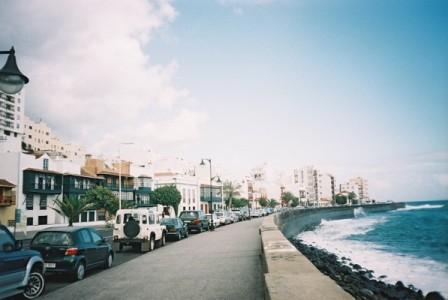
Santa Cruz de La Palma - a typical town in the Canary Islands (Jan 2004)
|
The Canaries are a group of seven spanish-owned volcanic islands lying some eighty miles off the west coast of Africa, the largest of which are about fifty miles in length. Their name derives not from the avian canary (which are instead named after the islands) but from canis the latin for dog due to the large number of wild dogs present during roman times. The native Guanche people ('men of the white mountains') were described by the spanish conquistadors as powerfully built, blue eyed and blonde. At the time of the spanish conquest, their lifestyle was one of hunter-gathering and they primarily lived in the volcanic caves that litter the islands. Their ethnic origins remain unclear, although it is known that the islands were already populated by around 200BC. The Guanches may have been of celtic origin, Norse, or possibly descended from the Berbers of Saharan Africa.
|
|
The islands were conquered by Spain in the fifteenth century, with spanish settlers largely displacing, killing, or selling into slavery the native peoples of the islands. Spain retained control of the islands despite challenges from both Britain and Holland in the sixteenth centuries.
The Canary islands, and in particular Tenerife and Lanzarote are now popular tourist resorts, in particular for young people. In addition to tourism, the islands have an economy based on the growth of banana palms and tobacco. The Island of La Palma, which boasts a dry climate and a tall volcanic caldera, also hosts Europe's largest astrophysical observatory.
|
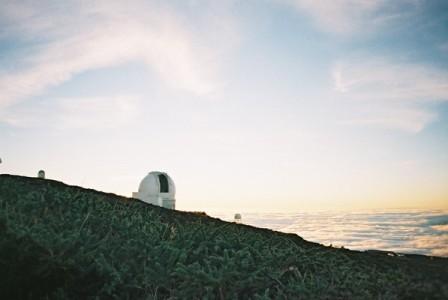
The William Herschell Telescope above the Atlantic clouds on La Palma, Canary Islands (Jan 2004)
|
Cornwall and the Eden Project
The 'Themaddon Climate Bubble' in 'A New Atlantis' was described as being near St Ives in Cornwall.
The fishing town and tourist resort of St Ives is in the far south western corner of England. It is named after St Ia, a young Irish woman who was left behind by a group of fellow missionaries, and obtained miraculous aid in crossing the Irish Sea, landing at St Ives. The town grew up around the oratory she was said to have founded on landing. The status of the town has waxed and waned with the business of its harbour - with both fishing fleets and the tin industry that made Cornwall famous adding to its wealth. Tourism is now St Ives' major industry and the town has both beaches and coastal walks, as well as historic buildings and a branch of the Tate art gallery.
 (Left) The Eden Project in October 2003 (photograph by Anne Stanway) |
The Eden project, to which John likened Themaddon's climate bubble in the CD, is at St Austell, not far from St Ives and also in Cornwall. The project is a complex of large geodesic dome greenhouses (including, in fact, the world's largest greenhouse) providing artificial climates that allow a wide range of ecosystems to be simulated. The greenhouses contain in excess of 100,000 plants of more than 5000 species. The mission of the Eden project is one of conservation, scientific research and education - encouraging a better understanding of the natural environment. It was constructed in a former quarry to mark the turn of the current millenium and was designed to make the plant world interesting and accessible to the general public.
|
DERA, Farnborough
The DERA research establishment at Farnborough appears in both 'Ghosts of Mendez' and 'A Living Hell' as the home institution of Dr Alexandra Caine.
Farnborough, about 50km south-west of London in Hampshire, is an ancient settlement which appears in the Doomsday Book. The word derives from the anglo-saxon for 'Fern Hill'. The town as it currently exists was largely shaped by construction of the nearby military base at Aldershot in the mid-nineteenth century, and by the opening of His Majesty's Balloon factory in 1906.
This centre evolved into the Royal Aircraft Establishment - one of Britain's premier aviation research centres. It was at Farnborough that Frank Whittle first developed the jet engine, that Concorde was designed, and that Thrust SSC (the first land vehicle to break the sound barrier) was developed. The research centre was taken over in the 1990s by DERA (the UK's Defence Evaluation and Research Agency). In 2001, DERA itself split into two bodies - the commercial wing QinetiQ (which contracts to both government and private industry) and the Ministry of Defence agency DSTL (the Defence Science and Technology Laboratory). The DSTL retained control of the Farnborough base.
Farnborough hosts an internationally famous biennial airshow which has been running since 1948. This has long been an opportunity for both commercial and military aircraft manufacturers to display and sell their new products, as well as an opportunity for the public to see aircraft in public display. Farnborough is also notable in a TP connection as the former location of Philip Gilbert's Prince Regent Theatre
Fylingdales Early Warning Station
In 'The Slarvian Menace', a vital part of the Slarvian's assault plan is the disabling of the Earth's early warning systems, and in particular, 'Wembley Moor Early Warning Station' in Northern England. The closest analogy to this location in the real world is the Ballistic Missile Early Warning System (BMEWS) site at RAF Fylingdales Moor in North Yorkshire.
The Fylingdales site was one of three forming a system to warn of ballistic missile attack in the northern hemisphere, primarily from the Soviet Union. The system could also track and monitor most satellites in Earth orbit. It was opened in 1962 at a cost of £46 million, and comprises three large 'golfball'-like radar enclosures (each more than 40 metres in diameter) which have been replaced by a more advanced system (a solid state phased array radar) mounted in the tetrahedral central building.
New York, USA
The city of New York, in the American state of New York, was the location for much of the audio drama `A Plague of Dreams'. Rachel Fox was incarcerated in the fictional `Florence Nightingale' juvenile penitentiary in the city.
Sited on land originally occupied by the native Lenape people, New York was founded in 1613, with the original name of `New Amsterdam' reflecting the origin of its Dutch settlers. It was conquered by Britain and renamed `New York' in 1664. It remained in British hands until 1783, and became the capital of the new United States between 1788 and 1790.
New York is now one of the most populous cities in North America, with a population of eight million. Its prosperity was built largely on control of the trade travelling on the Hudson river, and continues in no small part due to the presence of Wall Street and the New York Stock Exchange - the USA's major financial centre.
North Wales and Snowdonia
The (non-existent) village of Llan-y-Gwyliadwriaeth in North Wales was the setting for 'Sign of Diolyx', while Snowdonia and Snowdon itself appear in 'A Living Hell'.
The welsh nation has a long history, and the welsh-speaking villages of central and North Wales retain many aspects of the welsh culture. The North Wales coast is famous for its castles, some built to defend against the English, others to defend the English against the rebellious welsh! In fact, Wales has more castles per unit area than any other part of the world. Many of the most famous castles in Wales date from the reign of Edward I of England around 1200AD. The Principality of Wales has been subject to the English throne since the late thirteenth century and is part of the United Kingdom of Great Britain and Northern Ireland (although it now has a seperate assembly to consider issues relating only to Wales).
The Snowdonia National Park was created in 1951 and covers more than 800 square miles of northern Wales. As well as the mountainous regions which include Snowdon itself, the national park includes many small villages and farms. There are fifteen summits taller than 3000ft in the region, of which Snowdon (Yr Wyddfa) is the tallest at 3560ft (1085m). The summit of Snowdon can be reached by Britain's only public rack railway.
Oxford Street, London
Oxford Street in central London is the busiest shopping street in Britain. Amongst its 300 shops, Oxford Street boasts the oldest record shop in the world - a branch of HMV records. It occasionally hosts celebrity events similar to those portrayed in 'The New Gods' when Zane and Katya made a public appearence there.
|
Like many of London's main thoroughfares, Oxford Street follows the path of a Roman road. For many centuries its most important role was as the last road taken by prisoners from Newgate Prison to Tyburn Gallows. The street's current role as a shopping centre developed in the closing years of the eighteenth century. The number of shops in the area increased over the following century and by the start of the twentieth century, it was starting to become the venue for the large department stores which still exist there.
As well as its shops, the street is famous for its christmas illuminations, which are switched on ceremonially by a different celebrity every year.
|
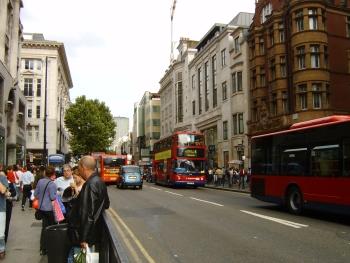
(Above) Oxford Street as seen from Oxford Circus in August 2006 |
Paris, France
Paris appears in the audio drama `A Plague of Dreams' as one of the targets of a rogue Tomorrow Person with few moral inhibitions. In the story, a large fraction of the city is destroyed, and much of the rest is heavily irradiated.
|
Paris,, the capital city of France, is one of Europe's ancient cities. Standing on the floodplain of the River Seine in north-east France, it has a reputation for culture and romance. There is evidence for occupation on the site from the Neolithic onwards, taking advantage of the navigable river and temperate climate. The gaulish Parisii tribe established a permanent settlement in the third century BC, and their town of Lutetia survived Roman occupation to become modern Paris two millenia later. Many of the avenues and buildings of Paris date from the nineteenth century - both from the reign of the Emperor Napoleon and his nephew Napoleon III, who reigned France between 1851 and 1870. Under Napoleon III, the Baron Haussmann oversaw a major reconstruction of the city centre, modernising and systematising the urban infrastructure.
|
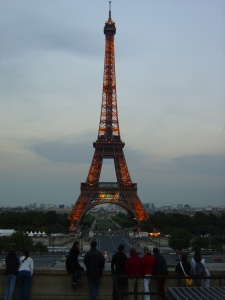 |
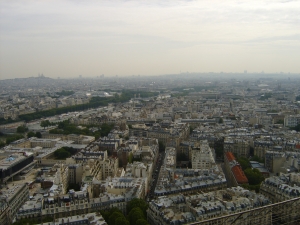 |
(Above) The Eiffel Tower, and (Left) a view of Paris from the second platform of the tower, in May 2005
Among Paris's prominent tourist landmarks is the 324m tall Eiffel Tower, constructed of an ornate steel lattice in 1889 for the Universal Exhibition. The tower has seen more than 220 million visitors since its construction, and is the property of the City of Paris.
|
Sahara Desert and Nomadic Tribes
The Sahara Desert, and its nomadic tribes, feature in `A Broken Dream'.
The desert occupies most of North Africa, above a latitude of about 16 degrees, with a total area of about 9 million square kilometres. Despite the arid conditions (only a few tens of millimetres of annual rainfall), the desert is home to between 2 and 4 million people (depending on how they are counted). The soil in the region is very low in organic matter and, as a result, relatively infertile. The area has a large fraction of mountainous terrain (25\%) and sand dunes (25\%), whilst the remainder is mostly arid and barren. A small fraction of the desert can be found in river valleys or relatively moist oases which can support settlement.
Those oases are vital to the largely nomadic lifestyle of many of the people of the region. Although regions of the desert have supported urbanised civilisations in the past, notably the Garamantes people of modern Libya, the majority of Saharan tribes rely on caravans of camels (introduced to the region by Arab traders) to traverse between the various oases. The dominant ethnicity in the North and North-west Sahara is that of the Berber tribes (native to the region), and the dominant religion is Islam (spread by trade and conquest in the 6th and 7th centuries AD). In some regions of the Sahara, black African ethnicities are dominant, and the language and religion varies significantly from tribe to tribe.
Shetland Islands
The Shetland Islands appeared in the audio adventure `Stemming the Tide'. The remote island chain hosted both Robert's holiday plans and a secret lurking under the surface of its society and its waters.
The Shetland Islands, a chain of small landmasses that lie on the boundary between the North Sea and the Atlantic Ocean, are the northernmost outliers of the British Isles. The administrative centre for the population of 22,000 is Lerwick on the largest of the island chain. The islands have been in continuous occupation since the Neolithic, having been colonised from both Scandinavia and Scotland in the intermediate period. The Norse influence on island culture remains strong. An annual fire festival known as Up Helly Aa is held in mid-winter, and includes the ritual burning of a viking longship. Sparse agriculture has left much of the islands' archaeology intact under the surface. As a result of its long occupation and cultural variety, sites of archaeological interest are a tourist attraction to the islands - as is its wild environment, much of which remains untamed.
The flora and fauna of the islands are governed by the temperate climate and northern latitude. Trees are sparse (partly as a result of deforestation by early settlers), and the islands are used for the grazing of native sheep varieties. The geographic isolation of the islands has led to the development of distinct Shetland varieties of pony and sheepdogs. Sea mammals including grey and common seals, harbour porpoises and otters are present in large numbers. Cetaceans, such as Orcas and Minkie whales, also migrate through the waters around the island chains.
In more recent times, the Shetland area has formed part of the North Sea oil fields and there is a large oil terminal at Sullom Voe. The petroleum industry generates about a third of the islands' income, with the bulk of the remainder from the fishing industry. The record of spillages from the oil industry has generally been good, although a major spillage occured in 1993 when the Braer tanker ran aground off Garth's Ness causing significant environmental damage.
A regular car ferry service now links Shetland to the Scottish mainland.
Tokyo, Japan
The city of Tokyo, and specifically the Millenium Tower, appears in `A Plague of Dreams' in which it is a target for the depredations of a rogue Tomorrow Person.
The Tokyo metropolis is the capital of Japan and lies on the Japanese island of Honshu. Once known as `Edo', the city rose to prominence in the early seventeenth century as the base of the Shogun Tokugawa leyasu. In 1869, the Emperor Meiji moved his imperial residence from Kyoto to Tokyo, confirming its importance. Tokyo suffered major disasters as a result of earthquakes (lying on the Pacific Rim of Fire) and of allied bombing during World War II. Despite these setbacks, the city rose to global economic prominence in the second half of the twentieth century. Tokyo is now a city of some 12 million people.
The Millenium Tower was a proposed project to construct an 840m, 180 floor, tall tower designed by Sir Norman Foster and accomodating 50,000 people. It was projected for completion in 2009, to be built on an artificial island. The project was shelved during Japan's financial recession of the 1990s.
Water Oakley
'The Warlocks Dance' was set in an Somerset village by the name of Water Oakley. While a village of this name does not exist, the name may well have been adopted due to its association with the Hammer film studios of the 1960s and 70s (In his sleeve notes to the CD, the writer Cavan Scott acknowledges a Hammer Horror influence).
From 1957 Hammer was based in Down Place (now Bray Studios) in the thamesside region of Water Oakley, Berkshire. Both the 1750s Down Place and the adjacent Oakley court (a castellated mansion built in 1857) appeared in several Hammer Films. The name 'Water Oakley' itself may originate from the ancient Cornish language (a relative of Breton) in which it translates roughly to 'Upper Salmon Place'. The village of Oakley lies just outside Windsor in Berkshire.
Buspace Studios
|
Recordings for the more recent stories in the Big Finish Tomorrow
People series have taken place at an audio recording suite at the
Buspace Studios in Notting Hill, West London. A former bus garage
building, it now houses 51 units, having been refurbished and extended
in 2001.
Earlier TP audio stories were recorded at the Moat Studios, Ladbroke Grove. (Right) The Buspace Studios, where Big Finish audio adventures were recorded. Photographed by Jackie Clark at the recording of the story 'End of Silence' on 10th September 2006.
| 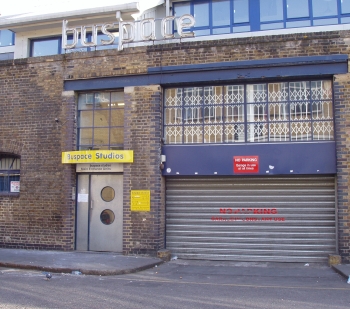 |